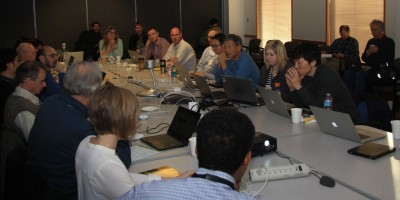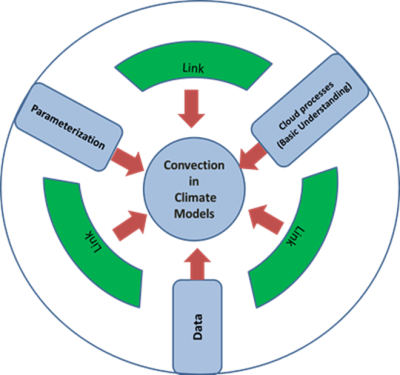
Atmospheric moist convection is a primary process through which much of the heat from the surface of the Earth is transported to the upper troposphere. This process starts out with the formation of small shallow clouds that rise from the boundary layer, which under the right environmental conditions grow into deep thunderstorms that produce rain.
These deep thunderstorms in turn could organize themselves into large aggregates of clouds, called mesoscale convective systems (MCSs). The latent heat release associated with the condensation and rain from these convective systems drives the atmospheric general circulation and controls the mean climate and its variability.
While clearly important, these processes have been too small to explicitly resolve in traditional climate models, which have grid-spacing of around 100 kilometers. Instead they have been parameterized by exploiting the fact that they act at scales much smaller than the resolution of the models. Advances in computational resources are enabling the building of climate models of much higher spatial resolution. This progress is creating both an opportunity and a challenge.

In order to draft a strategy for the accurate treatment of atmospheric moist convection in the next generation climate models, the U.S. Department of Energy’s Atmospheric System Research Program supported a workshop from February 3 to 5 at the Pacific Northwest National Laboratory in Richland, Washington.
The workshop identified six fronts on which the main challenges lie; the understanding of basic cloud processes, parameterization development, observations, and the links among them (see graphic below).

The participants of the workshop identified several specific questions related to interactions among large-scale environment (shear, moisture, surface conditions), cold pool dynamics, updraft/downdrafts, microphysical (especially ice) process, and their representation in the next generation climate models. They proposed a set of short-term and long-term integrated observing and modeling strategies to address them. A report on the outcome of the workshop is being prepared and will be made available at the ASR website when it is completed.
ASR principal investigators are an important user group for the ARM Facility, contributing 75 percent of scientific publications resulting from ARM data.
This work was supported by the U.S. Department of Energy’s Office of Science, through the Biological and Environmental Research program as part of the Atmospheric System Research program.

